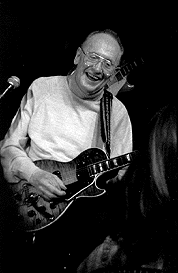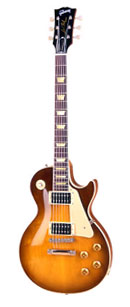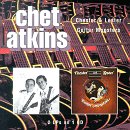| Les Paul
Yesterday I checked out Rhapsody for Les Paul. They have 3 albums (Emusic has none.) Great music!

 A lot of people know the Gibson guitars with the name Les Paul on them. Many, many more know the music that has come from these guitars — from musicians such as Eric Clapton, Jimmy Page and Jeff Beck. I suspect most don't know about the man behind the name. Not only was he instrumental (pun intended) in developing the solid body electric guitar, but he developed many of the recording techniques used by all rock musicians — and he is a *killer* guitar player. A lot of people know the Gibson guitars with the name Les Paul on them. Many, many more know the music that has come from these guitars — from musicians such as Eric Clapton, Jimmy Page and Jeff Beck. I suspect most don't know about the man behind the name. Not only was he instrumental (pun intended) in developing the solid body electric guitar, but he developed many of the recording techniques used by all rock musicians — and he is a *killer* guitar player.
Les Paul:
The Legend Plays On
Les Paul jokes that a lot of people don't know he plays the guitar. "They think I am one," he says with delight. As father of the solid body electric guitar, thousands of musicians around the globe covet Gibson's famed Les Paul guitars. But few realize the other contributions Paul has made through the years to the art of sound recording.
As an inventor, Les Paul is credited with creating sound-on-sound, over-dubbing, the electronic reverb effect and multitrack tape recording. He made the first eight track recorder in the late 1940s by stacking eight Ampex tape machines and synchronizing them. Old friend W.C. Fields dubbed the contraption "the Octopus." (...)
Beacham: How did you conceive the idea for multitrack recording?
Paul: That idea came about in the 1920s...long before tape recorders...with my mother's piano roll. You have to align a piano roll so it will play the right notes. I saw that the piano keys go down when there is a hole in the paper. I thought if I punch a hole somewhere else in that paper a key's gonna go down...and it did. There's a space on the roll with nothing on it. Now when the real roll came on...say it was Fats Waller playing something on the piano...there were a lot of places for me to play along with him. So I'd punch in extra holes and out would come extra notes. So I could make him play fifths, I could make him play thirds and I was having a field day with this thing. And so the first multiple ever made was with a piano roll. [read more]
2002 Les Paul series from Gibson
The Les Paul Pages
The Man who Turned on the Guitar
Les Paul and His Gibson Guitar
Because: He rocked our world.
Les Paul on Amazon
One of my most prized pieces of black vinyl is one I picked up in 1976 — Chester & Lester. Chet Atkins and Les Paul playing together for the first time. Two masters having fun together. I didn't realize there was a follow-up. It's on my wish list now (hint, hint).
Chester & Lester/Guitar Monsters
 Editorial Reviews — Amazon.com Editorial Reviews — Amazon.com
They weren't joined at the hip, yet Chet Atkins and Les Paul were far closer than many realize. Chet's half-brother Jimmy Atkins played rhythm guitar in the Les Paul Trio in the '40s. Both Chet and Les's playing reflected Belgian Gypsy jazz virtuoso Django Reinhardt's influence. They not only created records of monumental importance to guitarists in all genres, but their signature model electric instruments advanced guitar technology. In other words, ample common ground existed for these 1970s collaborations. The first, Chester & Lester, won the pair a Grammy in 1976; Guitar Monsters was the 1978 follow-up. Recorded in a loose, lighthearted atmosphere that bypassed country (except for the tongue-in-cheek "Give My Love to Nell"), these albums explored their roots in the big band era. In some cases, such as "It's Been A Long, Long Time" for Les and "Hot Toddy" for Chet, they revisited songs they recorded years earlier. Les, downplaying his electronic wizardry, proved that he didn't need it to dazzle. Chet, who'd come to favor sterile perfection over passion, unleashed his old intensity in the presence of a fellow virtuoso.
--Rich Kienzle
|

